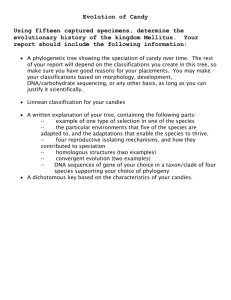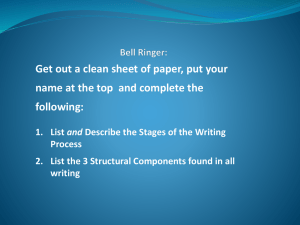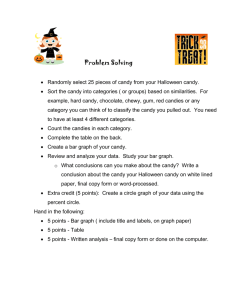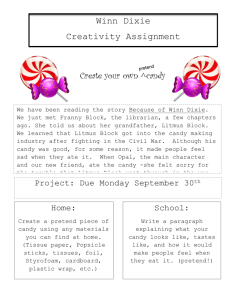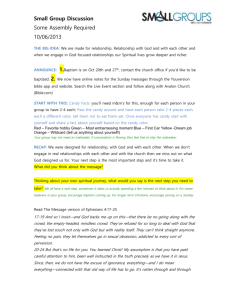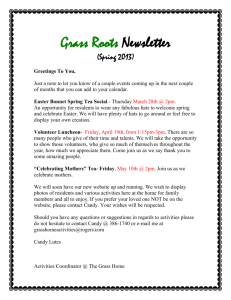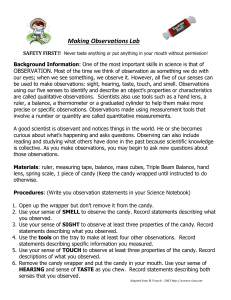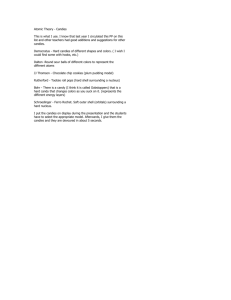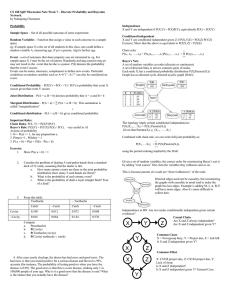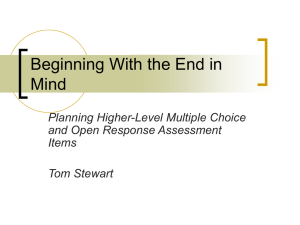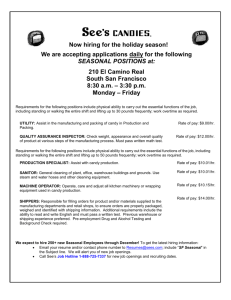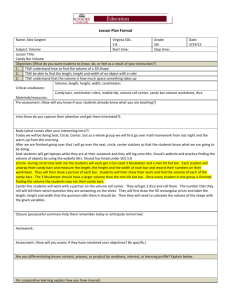Questions
advertisement
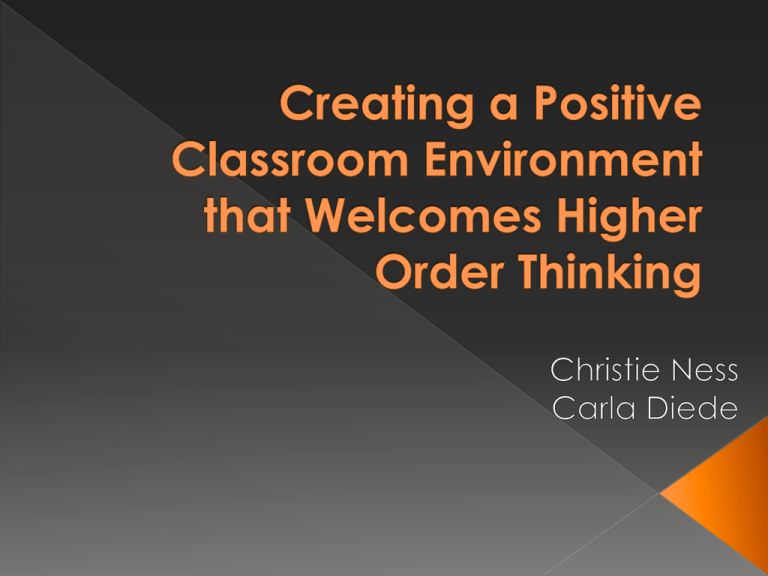
Students don’t care what you know until they know how much you care. Students’ environment is different from past students. Attainment of life skills is vital. Breaks down barriers to learning. Take time now to save time in the future. Best to start at the beginning of year Keep the goal in mind › What skill(s) are you focusing on? Don’t just do the activity to do it › Analyze the activity through questions › Expect more than “just because” answers › Push students to explain themselves and their feelings If you can get kids to think critically about a “fun” activity, then they will be more likely to do the same with a content-based activity Summary: Students try to focus on a story while multitasking by passing objects to other students. Instructions: › Each student needs a small object. › Students line up in 3 equal rows (need at least 9 students) › Read the “Another Day with the Wright Family” story › When left, right (or Wright), back or front is said each student passes one object in that direction “What” Questions › How hard was it to keep up with the story? › What problems did you have when passing the object? “So What” Questions › What impact did other’s actions have on your ability to stay up with the story? › How hard was it to listen and pass the objects at the same time? › How much of the story can you remember? › What role does concentration play in communication? “Now What” Questions › What problems can occur when we don’t communicate clearly? › How can we improve our communication with others? Summary: Similar to Mine Field activity. Students will need to direct another student through a golf course. Instructions: › Each student draws a 9 hole golf course and places an X to indicate a starting point. › Students are paired up and not allowed to see each others drawing. › Student A is blindfolded and student B describes to student A how to move through student B’s golf course. “What” Questions › How easy was it to follow the instructions that you were given? › Which role did you like better, giving or receiving the instructions? “So What” Questions › Would it have been easier if the person drawing could talk? Why or why not? › Describe a situation where unclear communication could be dangerous. › Whose role is more important, the person talking or the person listening? Why? › How can you be sure that someone has understood you correctly? “Now What” Questions › What steps can we take to communicate more clearly? Think-Pair-Share › Each student is given time to think about the topic on their own before sharing with a partner. One Sentence Stories › Students share a story with others, but are only allowed to say one sentence. 30 seconds and the Big Question › Students are given a question to discuss and each student is given 30 seconds to share their thoughts and ideas. Chips to Chat › Each student is given a single chip and must put it in the middle of the table to share. They cannot share again until everyone has shared. Then they start over. Sharing Circles › Students are given an allotted time to share. No one else may comment on what they said until they have gone completely around the circle and everyone has shared their ideas. Summary: Work as a group to write out the ABC’s as legible as possible. Instructions: › Need markers with strings attached to them and paper. › Students each grab one or two strings attached to the marker. › Students work together to hold the marker upright and write out the ABC’s “What” Questions › What was your first reaction to the challenge? › Did you come up with any strategies before starting? “So What” Questions › What can this activity teach us about working together? › If you become frustrated while working with the group what can you do to decrease your frustration? › Did you look at other teams to get ideas and would that be cheating? “Now What” Questions › If you fail the first time you try something what can you do to improve your chance of success? › How does working together help up solve problems? Trustworthiness Respect Responsibility Fairness Caring Group Dynamics › How many student to student interactions are you using? Keep it simple. Energize and engage students with the activity. You need to decide the purpose of the activity. Students should be at the center of everything you do. Three Types 1. Content/Thinking – focus on the thinking skills used and consists of facts, concepts and information 2. Collaborative/Social – focus on interaction that occurs between students and collaboration skills used 3. Personal – focus on what individual learned or felt Knowledge – Remember Comprehension – Understand Application – Apply Analysis – Analyze Synthesis – Create Evaluation – Evaluate Surface Area & Volume of Solids Questions: › What are the formulas you use to find the surface area of a prism and a cylinder? › How does the volume of a cone compare to the volume of a cylinder with the same height? › How would you modify a pyramid to increase its volume without changing its height? › How is the surface area of a prism related to the shape of its base? › How would you grade your partner’s analysis of how the prism’s base relates to its surface area? › What changes would you make to the candy wrapper to decrease the amount of wasted material? Forces Questions › Describe Newton’s three laws of Motion. › Compare the terms mass and weight. › Calculate the force of an object that weighs 45 kg and moves at a rate of 15 m/s/s. › Explain why and what would happen if I dropped an apple and a feather in a vacuum environment. › What changes would you make to your parachute to decrease the force on the egg. › How would you grade your partner/group on your parachute project. Handout: Blooms Find another person(s) in the room who teaches a similar subject and/or grade level 3-5 minutes › Think of a unit/chapter/lesson you will be teaching or have just finished teaching › Create at least one question at each level of thinking • Choose appropriate units and measure the dimensions of each piece of Remember candy and candy wrapper. Understand Apply • Find the surface area of each piece of candy and the area of each wrapper. • Calculate the amount of and percentage of wasted material. • Compare the amount of and percentage of each candies’ wasted space. Evaluate • Explain the criteria used to order the candies from least to most efficient. • Identify which candy company has the most inefficient wrapping procedures and write a letter outlining how it affects you as a consumer. Analyze • Include evidence to support your position and suggest a possible solution. Create Label the Read the current science article Summarize Newton’s variables and and relate the article to what three laws of motion units for force we have learned with force Illustrate a cartoon that describes one of Newton’s three laws Solve 3 of the 10 problems I created. You must use the three step process Explain why a shot gun “kicks” when fired. Make sure to use terms from this unit Create and Evaluate one of my solve your own force problems. force problem. Measure the force needed to move a 15 kg, 45 kg, and 75 kg object. Teaching steps for leaning concepts › Start with main idea and address preconceptions Use visual representation › Draw concepts or create mind pictures Clarify understanding versus memorizing Encourage questioning › Get students to lead their own learning through questions. Metacognition › Thinking about how they think and learn. Tom Jackson, 2000 : Still More Activities That Teach. Red Rock Publishing. Jeanne Gibbs, 1995: Tribes: A New Way of Learning and Being Together. Center Source Systems David A. Sousa, 2006: How the Brain Learns: Third ed. Corwin Press.
